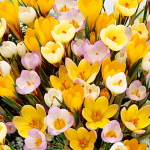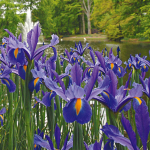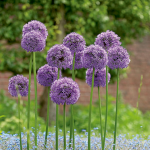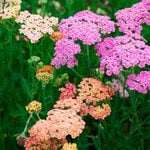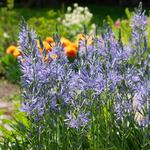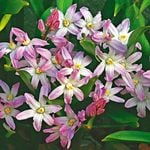Product Details
No matter how many sweet-smelling, brightly colored Hyacinths you have in your garden, you can always use more to bring indoors. That's why we created our Vivid Hyacinth Mix, a blend of premium bulbs that creates a rainbow of rosy red, pink, reddish purple, blue, and yellow flowers. Tantalizing when separated by color to match a room's decor or combined for maximum effect. Not labeled. 12 bulbs cover 2 sq ft. Exclusive.
Over centuries of breeding to increase the size, abundance, and color range of Hyacinth flowers, one thing remained the same—their rich perfume. Modern varieties can look a little stiff if they're lined up in the garden, so spread them around, combining them with Pansies and shorter Tulips. Plant the bulbs in full sun and rich, well-drained soil that stays warm and dry in summer when the bulbs are dormant. Order extra to force indoors in winter.
For more information on growing Hyacinth, click Growing Guide.
Shipping
HOW PLANTS ARE SHIPPED
The size of the plants we ship has been selected to reduce the shock of transplanting. For some, this means a large, bareroot crown. Others cannot travel bareroot or transplant best if grown in containers. We ship these perennials and annuals in 1 pint pots, except as noted. We must point out that many perennials will not bloom the first year after planting, but will the following year, amply rewarding your patience. We ship bulbs as dormant, bare bulbs, sometimes with some wood shavings or moss. Shrubs, Roses, vines, and other woody plants may be shipped bareroot or in pots. The size of the pot is noted in the quick facts for each item.
WHEN WE SHIP
We ship our bulbs and plants at the right time for planting in your area, except as noted, with orders dispatched on a first-come, first-served basis by climate zone. We also ship a wide range of containers and planters, tools, supplies, fertilizers, garden wear, garden decor items, as well as indoor decorations like wreaths and dried bouquets when available. Estimated dates for shipping are indicated in the green Shipping Details box for each item. Please supply a street address for delivery. Kindly contact us with two weeks notice, if you'll be away at the expected time of delivery.
OUR GUARANTEE
We guarantee to ship plants that are in prime condition for growing. If your order is damaged or fails to meet your expectations, we will cheerfully replace or refund it. Please contact our Customer Service Department at 1-800-503-9624 or email us at [email protected]. Please include your order number or customer number when contacting us.
Reviews
Average Customer Rating:
 (2 Reviews)
Write a Review
(2 Reviews)
Write a Review
Sort by:
Great combination 
A viewer from NYC
Delightful mix but heavy on dark colors 
Joe from Eastern Connecticut
Growing guide
Latin Name Pronunciation: hye-uh-sin'thuss or-ee-en-tal'iss
If we were taking bets on the most ravishing perfume of the spring garden, we'd back the Hyacinth. The heady fragrance of a handful of Hyacinths in full bloom is enough to sweeten a whole yard; a single pot of Hyacinths will fill your house.
Bulb size: 16-17 cm
Light: Most bulbs flower best in full sun (6 hours or more of direct sunlight per day) but tolerate light shade. They can thrive under deciduous trees, provided root competition is not too severe and the bulbs receive at least a half-day (3–4 hours) of sunlight after the trees leaf out.
Planting: Please note—Hyacinths bulbs may cause skin irritation in some people, so we recommend wearing gloves when handling. Bulbs are easy to plant. With a trowel or a bulb planter, dig a hole to the depth indicated on the plant label (about 6″ deep; use the label, which is 6″ long, as a rough measuring stick). Set the bulb in the hole with the flat side down and pointed end up. After you've placed the bulb in the hole, fill the hole with soil and water thoroughly.
Watering: Although there may be no signs of life above ground, bulbs begin sending out roots soon after planting -- as long as the soil is sufficiently moist. Unless you expect a soaking rain within a day or two of planting, we recommend that you water thoroughly after you plant. Water newly planted bulbs again only if rainfall is scarce. Once established, most bulbs want ample moisture— ½–1″ of rain per week—while in active growth (which begins in fall, slows or stops in winter, and resumes in late winter or early spring) and require soil that is on the dry side during summer dormancy. Do not plant bulbs near soaker hoses or sprinklers.
Fertilizer/Soil and pH: Hyacinth bulbs require soil that drains well the year round. To improve the drainage of heavy soil, dig in organic matter such as compost, aged manure, leaf-mold, peat moss, or (in the South) shredded pine bark. If you garden in very heavy clay, consider constructing raised beds to provide well-drained conditions. Hyacinths tolerate acid soil but thrive in neutral to slightly alkaline soil. The best time to fertilize bulbs is in fall, when they are sending out new roots. The next best time to fertilize is in early spring, just as the foliage begins to push through the soil. We recommend using a slow-release fertilizer formulated especially for bulbs, such as a granular Daffodil fertilizer. It's an easy matter to apply the fertilizer to the surface of the soil above the bulbs after planting and then every fall thereafter. We do not recommend using bone meal. It contains only one primary nutrient (phosphorus) and attracts dogs and rodents, which may dig up the bulbs.
Bloom time: The bloom times printed on our labels are typical of bulbs grown in Litchfield, Connecticut. Where spring comes earlier, bloom will generally be earlier. Likewise, in colder climates, flowering will be delayed. Please note that the first spring after planting, most bulbs (particularly those imported from cool-summer climates such as those of Holland and England) bloom later than established bulbs of the same variety. This is not unusual. In subsequent years, they will bloom at the appointed time.
Dormancy: Most of the bulbs we offer go dormant within about 8–12 weeks after flowering. The period between the end of flowering and the withering of the foliage is crucial to the future vigor of the plant. If you cut, fold, or braid the leaves before they have yellowed and collapsed, you may prevent the bulb from storing the energy required to bloom the following year. You can hide curing foliage by interplanting bulbs with leafy perennials such as Hostas, Daylilies, and Ferns or with annuals or ground covers. If you plant bulbs in a lawn, do not mow the grass until the bulb foliage begins to yellow.
Transplanting and dividing: The best time to move or divide bulbs is when their foliage has all but withered, signaling the end of active growth. Lift them with a digging fork or a spade, taking care to avoid injuring the bulbs, and replant them immediately at the same depth and about three times their diameter apart.
Winter protection: In Zone 6 (-10°F) and colder, all bulbs planted at a depth of less than 6″ benefit from winter protection. The purpose of winter protection is to prevent bulbs from being heaved out of the ground by the alternate thawing and freezing of the soil in winter. To prevent heaving, put a 4–6″ layer of loose organic material such as straw, oak leaves, or evergreen boughs (cut into 1–2′ lengths) over the ground after the ground freezes (generally in December here in Litchfield). Remove this winter cover gradually in late winter or early spring.
Pests: Bulbs as a group are not much troubled by insects or diseases, but in some areas, rodents or deer may eat the bulbs, foliage, or flowers.
Forcing Cold-Hardy Bulbs: Many spring-flowering bulbs can be tricked or "forced" to bloom indoors in winter, providing color and fragrance when few plants are stirring outdoors. "Rooting time" refers to the amount of time during which cold-hardy bulbs must be kept cold (about 40°F) and moist before they can be brought into bloom.
Containers and potting mix: You can use any pot you like to hold bulbs for forcing, as long as it allows room for root growth—about 3–4″ of space below the bulbs. If you choose a pot without a drainage hole in the bottom, you'll have to water your bulbs very carefully; bulbs sitting in soggy potting mix soon rot. We recommend that you force bulbs in a soilless potting mix (available at garden centers and hardware stores). A soilless mix holds moisture but allows excess water to drain away readily.
Potting the bulbs: To pot the bulbs, begin by placing potting mix in a plastic tub or bucket. Slowly add water and stir until the mix is moist but not soggy. Add moistened mix to the container until the container is about ½ full. Set the bulbs with the flat side down on top of the mix. Space the bulbs much more closely than you would in the garden; they should almost touch. Then add more mix to cover the bulbs. Cover the bulbs up to their necks, leaving the tips of the bulbs exposed. Water thoroughly after potting.
Chilling the bulbs: To force cold-hardy bulbs into bloom, you must first encourage them to produce new roots by keeping them cold and moist for a period of time that varies by type of bulb (12–14 weeks for Hyacinths). The ideal rooting temperature also varies, but most bulbs flower best if stored at 40–60°F for the first 3–4 weeks after potting, then at 32–40°F for the balance of the cooling period—a shift that mimics the drop in soil temperature outdoors as fall turns to winter.
You can also chill bulbs in a cold basement, an unheated garage (provided the temperature doesn't fall below freezing), or a refrigerator. In such locations, it may be difficult to arrange for the shift in temperature described above, but most bulbs will root properly if the temperature does not stray too far above or below 40°F during the rooting time.
If rodents have access to your bulbs, they may devour them, so protect potted bulbs with steel mesh or another barrier that still allows air circulation.
Please note that moisture is as important as temperature in the successful chilling of bulbs. Check the potting mix in the pots every few weeks and water thoroughly when the surface of the mix is dry to the touch.
Toward the end of the recommended rooting time, begin checking the pots for signs that the bulbs have rooted. If you see fleshy white roots poking through the drainage holes in the bottom of the pots, the bulbs are usually ready to bloom. If you don't see roots, give the bulbs more time in cold storage. Don't judge readiness by the appearance of shoots from the tops of the bulbs; without roots, the bulbs won't flower properly.
Once the bulbs have rooted, you don't have to bring them out of the cold immediately. Most tolerate extra chilling time, allowing you to orchestrate a succession of winter bloom.
Bringing the bulbs into bloom: When the bulbs have rooted, bring the pots out of cold storage and set them in a bright window in a cool room (one where the temperature stays below 65°F). Bright light will help keep the leaves and flower stems compact; in weak light, they tend to flop. You are likely to find that the bulbs have produced white shoots during cold storage. Sunlight quickly turns them green.
Keep a close eye on the moisture needs of the bulbs as they send up leaves and flower stems. Initially, the bulbs probably won't need to be watered more often than once a week (if that much), but by the time they bloom, you may need to water them every day or two.
Most bulbs will bloom 2–5 weeks after they come out of the cold, heralding spring with their bright colors and sweet fragrances. Duration of bloom varies with the type of bulb and the variety but is generally shorter than you'd expect of bulbs in the garden. Warm temperatures and low humidity indoors speed the decline of the flowers. Keeping the pots out of direct sunlight and moving them to a cool room at night helps prolong bloom.
When the blooms fade, we recommend that you toss the bulbs on the compost pile. If you keep them in a sunny window and continue to water them, forced bulbs can be planted in the garden after the threat of hard frost has passed, but they won't bloom well again for at least 2 years. It's better, in our view, simply to buy enough bulbs for planting indoors and out.
Forcing Hyacinths without soil: Hyacinth bulbs can be forced in pebbles and water, or in glass jars. They still require a cool rooting period if forced this way. Special forcing glasses, in use since Victorian days, are shaped like an hourglass and keep the bottom of the bulb dry—only the bulb's roots reach down into the water. Then place the container in a dark, cool area (40–50° F) for 4–8 weeks. Check the water level occasionally and add more water as necessary, keeping the water level below the bottom of the bulb. When roots have developed and the leaves begin to grow, it is time to move the bulb into a bright window in a cool room (one where the temperature stays below 65°F). Bulbs forced in water can be planted in the garden after the threat of hard frost has passed, but they won't bloom well again for at least 2 years.

